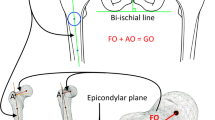Abstract
Dysplasia of the hip, the most common cause of secondary coxarthrosis, has a relatively high prevalence in Japan. Rotational acetabular osteotomy (RAO) is an interventional strategy that seeks to reduce the abnormal amount of high stress concentration in the acetabulum and thereby to prevent the development of coxarthrosis. Long-term clinical results have been reported, but functional evaluations of the gait before and after RAO are underreported. The aim of our recently initiated long-term prospective study is to assess the effect of RAO on the gait characteristics of patients using quantitative gait analysis. Thus far 22 patients (1 male, 21 females; mean age 30 years, range 15–43 years) have been enrolled, treated, and completed the preoperative and postoperative gait analyses. Hip pain during walking decreased in all patients after the RAO. The postoperative hip extension motion angle on the treated side increased significantly and correlated positively with the improvement in the Japanese Orthopaedic Association (JOA) pain score. The current study shows that coxalgia and gait function improved after RAO.
Similar content being viewed by others
Author information
Authors and Affiliations
About this article
Cite this article
Endo, H., Mitani, S., Senda, M. et al. Three-dimensional gait analysis of adults with hip dysplasia after rotational acetabular osteotomy. J Orthop Sci 8, 762–771 (2003). https://doi.org/10.1007/s00776-003-0705-z
Received:
Accepted:
Issue Date:
DOI: https://doi.org/10.1007/s00776-003-0705-z




